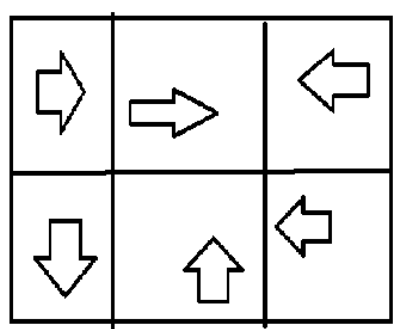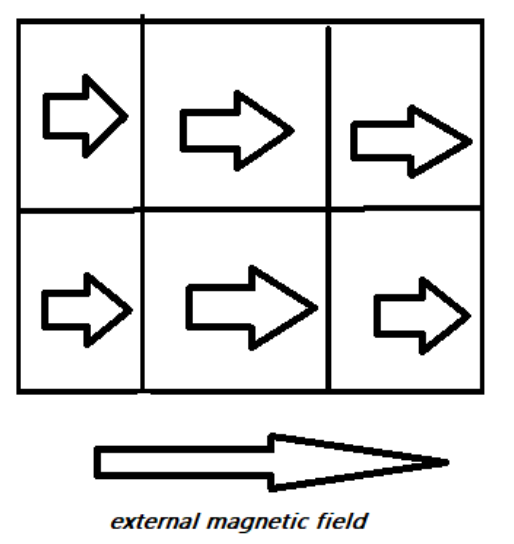
Explain ferromagnetism on the basis of the domain theory.
Answer
579.3k+ views
Hint: We encounter magnets in real life. These magnets are broadly classified into the following type based on their internal structure: ferromagnetic, ferrimagnetic, paramagnetic, and diamagnetic.
Complete step-by-step answer:
Ferromagnetic magnets are the strongest type of magnetic material. These are available in nature directly like iron, cobalt, or made at factories like the alloys of iron, cobalt, and nickel to name a few. These are further classified into a soft and hard material.
According to the magnetic domain theory, the magnetic material is divided into tiny regions called the magnetic domains. Each domain has a spin in a particular direction. But when the domain of the bulk is taken, the directions of the magnetic spins cancel each other.

Thus the bulk of the material does not show any magnetic property. But when an external magnetic field is brought near the domains, they interact with the external field and align themselves according to the external field. The new domains now formed have magnetic properties.

The magnetic property of the material is proportional to the temperature, as the rise in temperature results in increased thermal motion, which helps in the alignment of the domains.
The main observations of the domain theory of ferromagnetism are:
1. the ferromagnetic material becomes strongly magnetic, even with the presence of a small or weak magnetic field.
2. the ferromagnetic material loses its magnetic property if the external magnetic field is removed.
3. the magnetic property increases with temperature, till it reaches the Curie temperature. After which the magnetic property decreases if there is a further increase in the temperature.
Note: The strength of the magnets can be increased by exposing these magnets to external magnetic fields, or by increasing the temperature of the material. Also, ferrimagnets are mostly permanent in nature. Most of the electronic devices contain tiny electromagnets in them.
Complete step-by-step answer:
Ferromagnetic magnets are the strongest type of magnetic material. These are available in nature directly like iron, cobalt, or made at factories like the alloys of iron, cobalt, and nickel to name a few. These are further classified into a soft and hard material.
According to the magnetic domain theory, the magnetic material is divided into tiny regions called the magnetic domains. Each domain has a spin in a particular direction. But when the domain of the bulk is taken, the directions of the magnetic spins cancel each other.

Thus the bulk of the material does not show any magnetic property. But when an external magnetic field is brought near the domains, they interact with the external field and align themselves according to the external field. The new domains now formed have magnetic properties.

The magnetic property of the material is proportional to the temperature, as the rise in temperature results in increased thermal motion, which helps in the alignment of the domains.
The main observations of the domain theory of ferromagnetism are:
1. the ferromagnetic material becomes strongly magnetic, even with the presence of a small or weak magnetic field.
2. the ferromagnetic material loses its magnetic property if the external magnetic field is removed.
3. the magnetic property increases with temperature, till it reaches the Curie temperature. After which the magnetic property decreases if there is a further increase in the temperature.
Note: The strength of the magnets can be increased by exposing these magnets to external magnetic fields, or by increasing the temperature of the material. Also, ferrimagnets are mostly permanent in nature. Most of the electronic devices contain tiny electromagnets in them.
Recently Updated Pages
Master Class 12 Business Studies: Engaging Questions & Answers for Success

Master Class 12 Economics: Engaging Questions & Answers for Success

Master Class 12 English: Engaging Questions & Answers for Success

Master Class 12 Maths: Engaging Questions & Answers for Success

Master Class 12 Social Science: Engaging Questions & Answers for Success

Master Class 12 Chemistry: Engaging Questions & Answers for Success

Trending doubts
What are the major means of transport Explain each class 12 social science CBSE

Which are the Top 10 Largest Countries of the World?

Draw a labelled sketch of the human eye class 12 physics CBSE

Explain sex determination in humans with line diag class 12 biology CBSE

The pH of the pancreatic juice is A 64 B 86 C 120 D class 12 biology CBSE

Explain sex determination in humans with the help of class 12 biology CBSE




